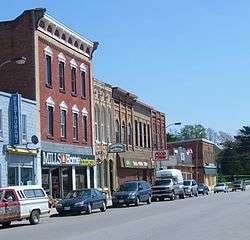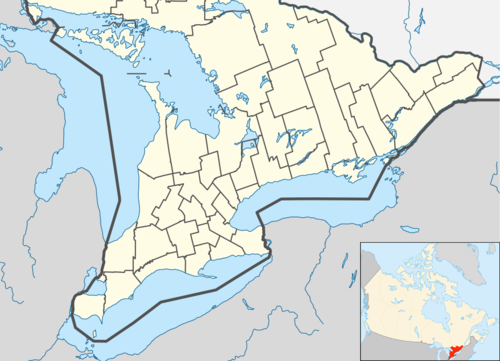Tara, Ontario
Tara is an unincorporated community in the municipality of Arran–Elderslie, Bruce County, in southwestern Ontario, Canada.[1][4][5] It is a designated place and had 1,037 residents and 458 dwellings as of the 2011 census.[3] Tara is in geographic Arran Township[6] and is located on the Sauble River.[4] It has an area of 2.39 square kilometres (0.92 sq mi) and an urban area that covers 63.5 square kilometres (24.5 sq mi).
Tara | |
|---|---|
Community | |
 View of Yonge Street | |
| Motto(s): Tarry Awhile in Tara | |
 Tara Location in southern Ontario | |
| Coordinates: 44°28′40″N 81°08′44″W[1] | |
| Country | Canada |
| Province | Ontario |
| County | Bruce |
| Municipality | Arran–Elderslie |
| Area | |
| • Total | 2.39 km2 (0.92 sq mi) |
| Elevation | 233 m (764 ft) |
| Population (2011)[3] | |
| • Total | 1,037 |
| • Density | 430/km2 (1,100/sq mi) |
| Time zone | UTC-5 (Eastern Time Zone) |
| • Summer (DST) | UTC-4 (Eastern Time Zone) |
| Postal Code | N0H 2N0 |
| Area code(s) | 519, 226, 548 |
Tara is in the federal electoral district of Bruce—Grey—Owen Sound and in the provincial electoral district of the same name.
Tara Siding is just to the south of the community on the right (opposite) bank of the Sauble River.[7] It was created in 1855 by the building of the Stratford and Huron Railway (later Grand Trunk Railway; later Canadian National Railway Owen Sound Subdivision; abandoned 1993).
History
Richard Berford and John Hamilton were the first European settlers to move onto and survey the lots of the future village of Tara in 1851. The opening of the road from Southampton to Owen Sound in 1852 helped the early growth of the community, as the village is located approximately half-way in between the two larger towns. Shortly after, Hamilton opened a hotel, serving the incoming settlers of the surrounding townships.[8] A post-office opened in 1862 with the name, Eblana, however it was changed the following year to Tara, after a town in County Meath, Ireland which served as the seat of Irish royalty.[9] In 1880, the local newspaper, The Tara Leader was first published, and the following year the railroad was built to the community and the first locomotive arrived.[10]
In 1855, a sawmill opened by H. W. M. Richards, becoming the first "manufacturing industry"; a grist mill was added to it in 1857. Two years later, a large foundry and agricultural implement works was started by W. A. Gerolamy. Other earlier businesses included a steam sawmill, a woolen mill and a potash factory. The first post office opened in 1862. The railway reached Tara in October 1881. The village never did become a major manufacturing centre.[11]
The Government of Ontario has erected a historic plaque in Tara, offering a glimpse into the past of this area.[12] The plaque titled THE FOUNDING OF TARA reads as follows. "Soon after the survey of Arran Township was completed in 1851. John Hamilton and Richard Berford, early settlers in the area, located here along the Sauble River. The opening of the Owen Sound Post road stimulated the growth of a small community and in 1858 Berford registered a village plan. Situated in a rich agricultural region wuth abundant water power, the settlement developed quickly. By 1861 it contained saw and grist mills, a foundry producing agricultural implements, wagon works and a tannery, and the following year a post office was established. Tara became a thriving commercial and manufacturing centre and, in anticipation of the arrival of the Stratford and Huron Railway, it was incorporated as a village by a county by-law effective January 1, 1881."
Economy
Tourism
The Arran-Tara Agricultural Society holds an annual fair, the Arran-Tara Fall Fair; it was first held in 1858.[13]
The Tara Santa Claus Parade is held every year on the first weekend of December.
Education
Tara's public elementary school is the Arran-Tara Elementary School, part of the Bluewater District School Board; there are no secondary or Catholic separate schools in Tara.[14]
Religion
Tara has four churches:[15]
- Christ Anglican Church, affiliated with the Anglican Church of Canada; part of the Diocese of Huron, Parish of Chesley, Tara, Paisley, Desboro and Walter's Falls; located at 102 Bruce County Rd 17
- Tara United Church, affiliated with the United Church of Canada
- Cornerstone Presbyterian Church, affiliated with the Presbyterian Church in Canada; formed in 2008 by the amalgamation of Knox Presbyterian in Tara and the Presbyterian church in the nearby community of Allenford.[16]
- Glad Tidings Mennonite Fellowship Church
Notable individuals
The Government of Ontario's historic plaques provide information on two individuals from this area.[12] The first discusses an athlete. "CYCLONE" TAYLOR 1885 - 1979. An outstanding hockey player, Frederick W. Taylor was born in Tara and began his amateur career with the Listowel juniors about 1901. His exceptional skating ability and irrepressible energy drew widespread attention to "Whirlwind" (later "Cyclone") Taylor and in 1905, in Michigan, he entered the International League, hockey's first professional organization. Having joined the Canadian civil service in 1907, he continued to play with Ottawa and Renfrew teams, and soon confirmed his reputation as a brilliant all-round player. He concluded his celebrated hockey career with the Vancouver Millionaires, 1912–20, of the Pacific Coast Hockey Association. In 1946 he received the Order of the British Empire for his service to the immigration department. "Cyclone" Taylor was elected to the Hockey Hall of Fame in 1947."[17]
The second plaque refers to a prominent lawyer. "SIR WILLIAM H. HEARST 1864 - 1941. Born in Arran Township, Hearst was educated at the Collingwood Collegiate and Osgoode Hall. He practised law at Sault Ste. Marie and was first elected to the provincial legislature as Conservative member for that community in 1908. He was appointed minister of lands, forests and mines in 1911 during the administration of Sir James Whitney, and following the latter's death in September, 1914, became Ontario's seventh prime minister. Hearst retained that post throughout the first World War and was knighted for his services. Following his government's defeat in 1919 by the United Farmers of Ontario, he retired from politics, but served as a member of the International Joint Commission on Boundary Waters, 1920-40."
A more recent notable former resident - Jeff Sprung now known as "Jeff Kelly" - is a radio personality currently residing in London working for 97.5 Virgin Radio as the afternoon drive show host weekdays 2-6 pm. Previous to his role he worked in London, Barrie, Winnipeg, and Ottawa. He attended Arran Tara Elementary School and the nearby Chesley District High School.[18]
Notes
- "Tara". Geographical Names Data Base. Natural Resources Canada. Retrieved 2017-03-17.
- Elevation taken at geographic coordinates from Google Maps. Accessed 2017-03-17.
- "Designated places: Ontario". Population and dwelling counts, for Canada, provinces and territories, and designated places, 2006 and 2001 censuses - 100% data. Statistics Canada. Retrieved 2017-03-17.
- Map 4 (PDF) (Map). 1 : 700,000. Official road map of Ontario. Ministry of Transportation of Ontario. 2016-01-01. Retrieved 2017-03-17.
- Restructured municipalities - Ontario map #6 (Map). Restructuring Maps of Ontario. Ontario Ministry of Municipal Affairs and Housing. 2006. Retrieved 2017-03-17.
- "Township of Arran" (JPG). Canadian County Atlas Project. McGill University. 2001. Retrieved 2017-03-17.
- "Tara Siding". Geographical Names Data Base. Natural Resources Canada. Retrieved 2017-03-17.
- Robertson, 274-275.
- Robertson, 274-276.
- Robertson, 277.
- "Village of Tara". Electric Scotland. Alastair McIntyre. 2015. Retrieved 4 March 2017.
From the book History of the County of Bruce, Ontario, Canada, by Norman Robertson (1906)
- Cook, Wayne (2013). "Historical Plaques of Bruce County". Wayne Cook. Wayne Cook. Retrieved 3 March 2017.
- "Arran-Tara Agricultural Society". Arran-Tara Fall Fair. Retrieved 2005-06-08.
- "Arran-Tara Elementary School". Bluewater District School Board. Retrieved 2005-06-08.
- Muir, Cathy. "Churches and Parishes In Bruce County". Bruce County GenWeb. Retrieved 2005-06-08.
- "About". Cornerstone Presbyterian Church. Retrieved 2017-03-17.
- Perkins, Mary Ellen (1989). Discover Your Heritage: A Guide to Provincial Plaques in Ontario. Dundurn. ISBN 0920474500.
- "Jeff Kelly". iHeart - Virgin Radio. 97.5 Virgin Radio. 2015. Retrieved 3 March 2017.
References
- Robertson, Norman (1971) [First published in 1960]. The History of the County of Bruce (3rd ed.). Owen Sound: Bruce County Historical Society; Richardson, Bond, and Wright. OCLC 16980677.